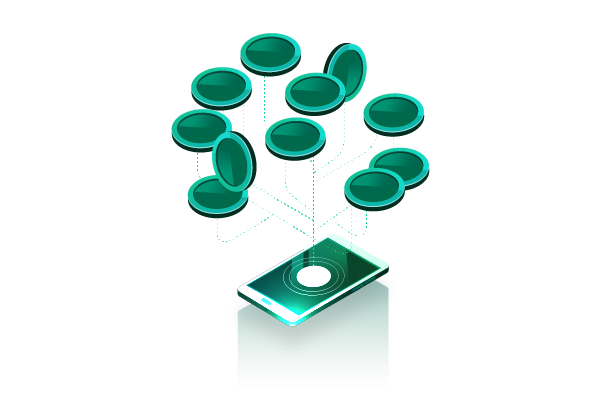As we move into 2025, the market for these top-tier cryptocurrencies continues to evolve, with new players entering the scene and established ones holding their ground. Blue chip cryptocurrencies typically include large-cap coins with significant user adoption and proven technology. They offer investors potential for long-term returns, making them attractive options for both beginners and seasoned crypto traders.
This updated guide will introduce you to the Top 10 Blue Chip Cryptocurrencies to Consider in 2025. Whether you’re diversifying your portfolio or simply exploring opportunities for the first time, these cryptocurrencies have demonstrated staying power and potential for future growth.
Why Blue Chip Cryptocurrencies Are a Stable Investment

Blue chip cryptocurrencies are often viewed as the cornerstone of a well-balanced investment portfolio. They offer stability in a market that is otherwise known for its volatility. Let’s explore the reasons why blue chip cryptocurrencies are considered a stable investment.
Established Market Presence
Blue chip cryptocurrencies, like Bitcoin and Ethereum, have been around for several years, with proven track records of surviving market downturns and regulatory challenges. Their longevity and continued relevance in the evolving crypto space provide investors with a sense of security. These coins have managed to build large communities and attract significant institutional backing, which contributes to their market resilience.
Also Read: 10 Best XRP (Ripple) Wallet to Check in 2024
High Liquidity
Liquidity is a key factor that distinguishes blue chip cryptocurrencies from other digital assets. These cryptocurrencies are widely traded across almost every major exchange, allowing investors to enter and exit positions without facing substantial price fluctuations. High liquidity ensures that these coins remain relevant and in demand, making them safer options compared to smaller, more speculative tokens.
Strong Technological Foundations
Behind every blue chip cryptocurrency is a robust technology that supports their long-term viability. For example, Ethereum’s smart contract platform has revolutionized decentralized applications, while Bitcoin’s decentralized and secure network has set the gold standard for digital currencies. Blue chip cryptocurrencies are typically backed by well-funded development teams, ensuring continuous improvements and adaptability to future market needs.
Institutional Adoption
One of the major drivers of stability in blue chip cryptocurrencies is institutional adoption. Major financial institutions, hedge funds, and large corporations are increasingly recognizing the value of cryptocurrencies like Bitcoin and Ethereum. Their involvement not only adds credibility but also injects large amounts of capital into the market, reducing volatility and driving long-term growth.
Hedging Against Inflation
Similar to gold and other precious metals, blue chip cryptocurrencies, especially Bitcoin, are often viewed as a hedge against inflation. With limited supply and deflationary models, they have become attractive to investors looking to protect their wealth from the eroding value of fiat currencies. As inflation concerns continue in traditional markets, blue chip cryptocurrencies offer an alternative store of value.
Top 10 Blue Chip Cryptocurrencies to Consider in 2025

Here are the top 10 blue chip cryptocurrencies to consider for investment in 2025, offering insights into their long-term potential and market relevance. As the cryptocurrency market continues to mature, it’s crucial to understand which projects have staying power due to their technological advancements, market cap, and community support. These ten digital assets have shown resilience and innovation, positioning themselves as key players in the evolving blockchain ecosystem.
1. Bitcoin (BTC)
Bitcoin, created in 2009, remains the first and largest cryptocurrency, often referred to as “digital gold” due to its limited supply and decentralized nature. It laid the foundation for the entire crypto industry, offering a peer-to-peer payment system that bypasses traditional financial institutions.
- Strengths: Bitcoin’s high liquidity, global recognition, and security make it a solid investment. The 2024 approval of Bitcoin ETFs has further solidified its position as a valuable asset, leading to a surge in institutional interest. Its deflationary model, with a capped supply of 21 million coins, adds to its appeal as a store of value, making it the go-to asset during times of economic uncertainty.
2. Ethereum (ETH)
Ethereum introduced smart contracts, enabling decentralized applications (dApps) and decentralized finance (DeFi) to flourish. Launched in 2015, it is the second-largest cryptocurrency by market cap and remains the backbone of much of the blockchain ecosystem.
- Strengths: The ongoing transition to Ethereum 2.0 promises to significantly improve the network’s scalability and reduce energy consumption. With a robust ecosystem of developers, dApps, and decentralized exchanges (DEXs), Ethereum continues to dominate the space, attracting users and developers from around the globe. Its versatility and constant updates make it a crucial part of any diversified crypto portfolio.
3. Solana (SOL)
Known for its high transaction speed and low fees, Solana has quickly emerged as a top platform for DeFi, NFTs, and other decentralized applications. It offers a competitive edge through its unique Proof of History (PoH) consensus, which ensures high throughput without sacrificing decentralization.
- Strengths: Solana’s ability to process thousands of transactions per second (TPS) positions it as one of the fastest and most scalable blockchains in the market. This speed, combined with a thriving developer community and increased adoption in both DeFi and NFT markets, makes it a key player in the blockchain world. Its low fees and ability to handle large volumes of transactions have made it a popular choice for users and developers alike.
4. Cardano (ADA)
Cardano is built on a foundation of peer-reviewed academic research, focusing on sustainability, security, and scalability. It has garnered a reputation for taking a slow and methodical approach to development, ensuring that its blockchain is highly secure and sustainable for the long term.
- Strengths: Cardano’s academic-driven approach has led to strong support from developers and researchers. Its emphasis on environmental sustainability, scalability, and real-world applications positions it as a blockchain solution for a wide variety of use cases. Cardano’s active development and upcoming updates make it an exciting project for the future, with a growing number of dApps and partnerships expanding its ecosystem.
5. Avalanche (AVAX)
Avalanche is a platform designed to launch decentralized applications and enterprise blockchain solutions. Known for its high performance, it aims to offer greater scalability and speed compared to older blockchain networks.
- Strengths: Avalanche’s unique architecture allows for near-instant finality, meaning transactions are confirmed within seconds. Its high throughput and ability to accommodate multiple blockchains within its network make it a versatile platform for developers and businesses. With a rapidly growing DeFi ecosystem and enterprise adoption, Avalanche is quickly becoming a favorite among developers seeking low latency and high performance.
6. Chainlink (LINK)
Chainlink is a decentralized oracle network that plays a crucial role in connecting smart contracts to real-world data. It ensures that blockchains can interact with external systems, making it essential for DeFi and other decentralized applications.
- Strengths: As the leading oracle solution, Chainlink is vital for DeFi protocols, providing accurate and reliable off-chain data for smart contracts. Its ability to integrate with multiple blockchains has made it indispensable in the decentralized finance ecosystem, ensuring that smart contracts can function correctly by accessing external data such as price feeds, weather reports, and more.
7. TRON (TRX)
TRON aims to decentralize the internet by building a global content-sharing platform. Launched in 2017, TRON is known for its focus on digital entertainment and content creation, offering fast and cheap transactions for users around the world.
- Strengths: With a strong community and high transaction throughput, TRON has established itself as a leading platform for decentralized applications, especially in the digital entertainment and content sharing sectors. Its partnerships with major companies and widespread adoption make it a strong contender in the race for blockchain dominance. TRON’s low fees and fast transaction speeds make it an attractive option for developers and users alike.
8. Ripple (XRP)
Ripple’s XRP is designed to facilitate fast and low-cost cross-border payments. Unlike many cryptocurrencies, XRP is tailored specifically for use by banks and financial institutions to streamline international money transfers.
- Strengths: Ripple’s partnerships with major financial institutions and banks have solidified its position as a bridge currency for global payments. Its low fees and quick transaction times make it ideal for real-world financial applications, giving it a distinct advantage in the cryptocurrency space. With ongoing legal challenges nearing resolution, XRP remains a strong contender in the cross-border payment industry.
9. Toncoin (TON)
Initially developed by Telegram, Toncoin is designed to offer fast, scalable solutions for decentralized applications. Despite facing challenges in its early development, Toncoin has gained traction in recent years due to its innovative technology and strong community support.
- Strengths: Toncoin’s focus on providing a highly scalable blockchain has attracted developers and users alike. Its unique consensus mechanism and focus on decentralized applications make it a standout project in the space. With growing adoption and a strong developer community, Toncoin is positioned for growth as more users and projects onboard.
10. Filecoin (FIL)
Filecoin is a decentralized storage network that allows users to rent out spare storage space, creating a distributed and secure way to store data. Launched in 2020, it aims to revolutionize the way data is stored and retrieved on the blockchain.
- Strengths: Filecoin’s decentralized storage model offers a unique use case that appeals to developers and enterprises looking for secure and efficient data storage solutions. Its integration with other blockchain ecosystems, combined with increasing enterprise interest, makes Filecoin a strong contender in the decentralized storage space. The demand for decentralized data storage is only expected to grow, positioning Filecoin as a long-term player in the market.
Factors to Consider Before Investing in Blue Chip Cryptocurrencies

While blue chip cryptocurrencies are generally seen as stable investments compared to smaller or newer digital assets, there are still several important factors to consider before making an investment. Understanding these aspects can help you make more informed decisions and maximize your investment potential.
Market Volatility
Even though blue chip cryptocurrencies are more stable than many other cryptocurrencies, they are not immune to market volatility. The value of cryptocurrencies can fluctuate significantly in short periods due to various factors such as market sentiment, regulation changes, or macroeconomic conditions. It’s important to have a high-risk tolerance and a long-term investment strategy when dealing with these assets.
Regulatory Environment
Cryptocurrencies operate in a regulatory grey area in many countries, and the legal status of digital currencies can change rapidly. Governments around the world are actively working on creating frameworks to regulate cryptocurrencies, which can impact the market. Before investing, it’s crucial to stay informed about the regulatory environment, as sudden changes in laws or regulations can affect the price and usability of certain cryptocurrencies.
Technological Risks
Although blue chip cryptocurrencies are backed by strong technology, they are not free from technical risks. Security breaches, hacking, or bugs in the underlying code can lead to loss of funds or reduced confidence in a particular cryptocurrency. Additionally, some projects may face challenges in scaling as they grow, which could affect their future viability. Investors should consider the technological risks associated with each cryptocurrency and ensure the platforms they invest in have robust security measures in place.
Competition and Innovation
The cryptocurrency market is highly competitive, with new projects and innovations emerging constantly. While blue chip cryptocurrencies have an established market presence, they must continue to evolve to maintain their relevance. For example, Ethereum faces competition from newer blockchains like Solana and Polkadot, which offer faster transaction speeds and lower fees. Investors should pay attention to how these blue chip projects innovate and adapt to stay ahead of the competition.
Long-Term Viability
When investing in blue chip cryptocurrencies, it’s essential to assess the long-term viability of the project. Does it have a clear use case, a strong development team, and a growing user base? Consider whether the cryptocurrency is solving a real-world problem and whether there is continuous demand for its technology. A long-term focus on utility and adoption is often a good indicator of a cryptocurrency’s staying power.
How to Safely Buy and Store Blue Chip Cryptocurrencies
Investing in blue chip cryptocurrencies is not just about picking the right assets—it’s equally important to know how to buy and store them safely. Below are the steps and best practices to ensure your investments are secure.
Choosing the Right Exchange
The first step in purchasing blue chip cryptocurrencies is selecting a reliable and secure exchange. Large, reputable exchanges such as Binance, Coinbase, and Kraken are popular choices for buying blue chip assets. These platforms offer high liquidity, a user-friendly interface, and strong security measures such as two-factor authentication (2FA) and cold storage for assets. It’s important to avoid lesser-known exchanges that may have weaker security protocols or insufficient liquidity.
Before making any transactions, ensure that the exchange you choose complies with local regulations and offers insurance on stored assets where applicable. Additionally, look for exchanges with a good track record and user reviews to avoid any potential scams or hacks.
Types of Wallets: Hot vs. Cold Storage
Once you’ve purchased your cryptocurrencies, you need to decide how to store them securely. There are two main types of cryptocurrency wallets: hot wallets and cold wallets.
- Hot Wallets are connected to the internet and are convenient for quick access to your assets, making them suitable for frequent traders. However, since they are online, they are more susceptible to hacking. Most exchanges offer hot wallets, but it’s advised to store only a small portion of your assets in them.
- Cold Wallets, on the other hand, are offline and provide greater security. These can be hardware wallets like Ledger or Trezor, which store your private keys offline. For long-term investors, cold wallets are the best choice, as they significantly reduce the risk of hacking and unauthorized access.
For blue chip cryptocurrency investments, which are often held for longer periods, it’s advisable to use cold storage whenever possible to protect your assets from potential cyber threats.
Also Read: 10 Best Ethereum Wallets to Consider in 2025
Backup and Recovery
When using a cryptocurrency wallet, whether hot or cold, you will be provided with a private key or a recovery seed phrase. This information is crucial for accessing your funds and must be stored securely. If you lose your private key or recovery phrase, you may lose access to your cryptocurrencies permanently.
Best practices for backup and recovery include writing down the seed phrase on paper and storing it in a secure location. Avoid keeping this information in a digital format, such as in emails or on your computer, as it can be hacked. For added security, you can also use multiple copies stored in different physical locations.
Protecting Against Scams and Phishing Attacks
Cryptocurrency investors are often targeted by scammers and phishing attacks. Be cautious of unsolicited messages, emails, or social media posts that promise guaranteed returns or ask you to send your cryptocurrency to a specific address. Legitimate projects and exchanges will never ask for your private key or ask you to transfer funds outside of their platform.
To protect yourself from scams, ensure that you’re only interacting with verified websites, exchanges, and wallets. Double-check URLs, use hardware wallets, and enable security features like 2FA on your exchange accounts. Additionally, be cautious when installing any cryptocurrency-related apps and only download them from official sources.
Conclusion
Blue chip cryptocurrencies continue to play a vital role in the growing digital economy, offering stability in an otherwise volatile market. Cryptocurrencies like Bitcoin, Ethereum, and others on the top 10 list have proven their resilience, establishing themselves as long-term assets. With increased institutional adoption and technological advancements, these blue chip assets are seen as safer investments compared to smaller, more speculative coins.
As we head into 2025, the continued development of decentralized finance (DeFi), NFTs, and Layer 2 scaling solutions will further solidify the importance of these digital currencies. Although the market is not without its risks—such as regulatory changes and technological challenges—the long-term prospects of blue chip cryptocurrencies remain strong. Their ability to innovate and adapt to new trends ensures they stay relevant as key components of the cryptocurrency ecosystem.
Disclaimer: The information provided by HeLa Labs in this article is intended for general informational purposes and does not reflect the company’s opinion. It is not intended as investment advice or recommendations. Readers are strongly advised to conduct their own thorough research and consult with a qualified financial advisor before making any financial decisions.

I am Carina Caringal, a technical writer specializing in blockchain engineering concepts, decentralized systems, crypto infrastructure, and Web3 technologies. My work focuses on analyzing and translating complex technical mechanisms into precise, structured, and insightful content for both developers and non-technical readers who want a deeper understanding of the decentralized ecosystem.
My background in blockchain and cryptocurrency is rooted in years of independent research, continuous learning, and hands-on exploration across multiple protocols and network architectures. I study the underlying mechanics of distributed ledger technology, from consensus algorithms and smart contract logic to network scalability, security models, cryptographic principles, and interoperability frameworks. This technical foundation shapes the way I approach every article, ensuring accuracy, depth, and relevance.
- Carina Caringalhttps://helalabs.com/blog/author/carina-caringal/
- Carina Caringalhttps://helalabs.com/blog/author/carina-caringal/
- Carina Caringalhttps://helalabs.com/blog/author/carina-caringal/
- Carina Caringalhttps://helalabs.com/blog/author/carina-caringal/

